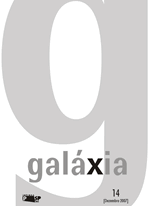Eidos em movimento: da ação à criação do audiovisual
Palabras clave:
audiovisual and philosophy, communication and Plato, image and movementResumen
A partir da célebre imagem bergsoniana do mecanismo cinematográfico da inteligência e da percepção, adentra-se ao mundo das idéias de Platão em busca da distinção entre o contínuo movimento do real e o eidos como representação estável da instabilidade das coisas. Os conceitos de eidos e movimento serão, então, empregados para analisar a concepção, a produção e a recepção de um produto audiovisual. A necessidade de estabilização do movimento real das coisas e dos acontecimentos é presente em vários momentos do processo audiovisual: no roteiro, que usa palavras de uma linguagem que solidifica a fluidez advinda da criação; no storyboard, que representa gráfica e estaticamente as ações mais importantes; no enquadramento das imagens, que separa do fluxo contínuo da realidade, os momentos privilegiados; no fotograma ou nos quadros videográficos, que são imagens imóveis do movimento real; na percepção do espectador, que capta os instantes da realidade para depois alinhá-los; na memória, que seleciona e separa os momentos mais marcantes do que foi percebido; e, finalmente, nos comentários do espectador, que fragmenta e narra as imagens mentais retidas.Descargas
Publicado
2007-07-11
Cómo citar
Rossetti, R., & Cardoso, J. B. F. (2007). Eidos em movimento: da ação à criação do audiovisual. GALÁxIA. Revista Interdisciplinar De Comunicação E Cultura, (14), p. 47–59. Recuperado a partir de https://revistas.pucsp.br/index.php/galaxia/article/view/1486
Número
Sección
Dossiê | Dossier
Licencia
Cedo a la revista Galaxia los derechos de autor para la publicación de mi artículo y consultaré al editor científico de la revista caso quiera republicarlo más adelante en un libro.



 Este obra está licenciada com uma Licença
Este obra está licenciada com uma Licença 